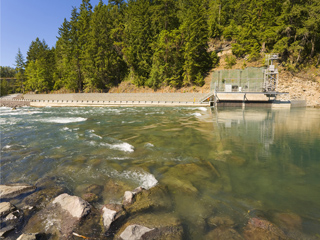National finalist:
Gold Award
Project: Elwha River restoration
Client: National Park Service

Photo courtesy of URS Corp. URS’s Elhwa River restoration was designed to provide safe fish passage and numerous resting places for migrating fish.
|
The Elwha River Ecosystem and Fisheries Restoration Act of 1992 required “full restoration of the Elwha River ecosystem and native anadromous fisheries” along the Elwha River in Clallum County.
To do this, the National Park Service needed to remove two hydropower dams (Elwha and Glines Canyon) built in the early 1900s, and protect downriver businesses, property and people from the more than 18 million cubic yards of sediment trapped behind the dams. URS Corp. was brought in to design and construct the Elwha surface water intake and the Elwha water treatment plant.
A key stakeholder was the Lower Elwha Klallam Tribe. The Elwha River ecosystem holds spiritual and cultural significance for the tribe, and their reservation is currently located near the mouth of the river. Tribe members historically fished in the river and relied on the salmon to support their families, so restoration of the river represents a significant step toward restoring the tribe’s historical livelihood and traditions.
Among the project’s complex web of environmental considerations, very stringent water quality and slurry waste-handling requirements had to be addressed at the treatment plant. URS applied a new ballasted sedimentation process for treating raw water that intensive testing had shown would meet all drinking water quality standards.
URS designed an “engineered riffle” that provides safe fish passage and numerous resting places for migrating fish.
A 180-cubic-feet-per-second intake facility was constructed on a steep slope beside the flood-prone Elwha River. The company designed a diversion channel by the water intake facility that could reroute the entire flow of the Elwha River during construction periods. The large peak water flows and sediment loads required URS engineers to push the limits of technology. Ultimately, the problems were solved with the installation of high- and low-flow pumps and the use of treatment processes arranged in parallel so they could be brought on- and off-line individually.
The dam removal project is the largest of its kind in the United States, and the second-largest National Park Service restoration project in U.S. history, behind the Everglades National Park in Florida. URS’s water treatment facilities and the surface water intake structure are designed to ensure a clean water supply for people and a healthy environment for endangered fish and other wildlife over the five-year dam removal process.